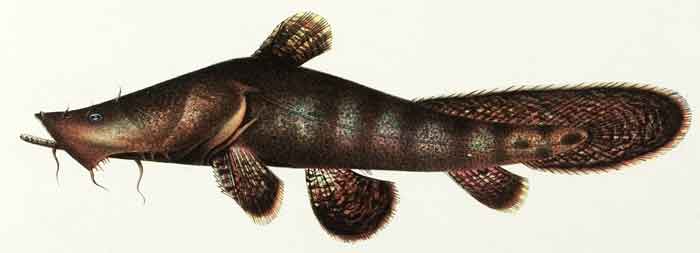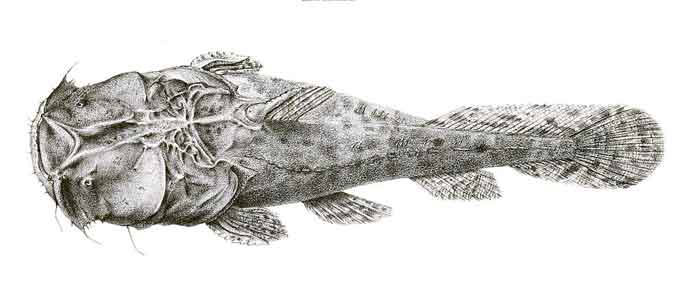Superregnum: Eukaryota
Cladus: Unikonta
Cladus: Opisthokonta
Cladus: Holozoa
Regnum: Animalia
Subregnum: Eumetazoa
Cladus: Bilateria
Cladus: Nephrozoa
Superphylum: Deuterostomia
Phylum: Chordata
Subphylum: Vertebrata
Infraphylum: Gnathostomata
Megaclassis: Osteichthyes
Superclassis/Classis: Actinopterygii
Classis/Subclassis: Actinopteri
Subclassis/Infraclassis: Neopterygii
Infraclassis: Teleostei
Megacohors: Osteoglossocephalai
Supercohors: Clupeocephala
Cohors: Otomorpha
Subcohors: Ostariophysi
Sectio: Otophysa
Ordo: Siluriformes
Familia: Chacidae
Genus: Chaca
Species: C. bankanensis – C. burmensis – C. chaca – C. serica
Name
Chaca Gray, 1831: 9
Type species: Chaca hamiltonii Gray, 1831 (= Platystacus chaca Hamilton, 1822). Type by monotypy.
Synonyms
Brachystacus Van der Hoeven, 1855: 280
Chaca Valenciennes, 1832: 386
References
Gray, J.E. 1831: Description of twelve new genera of fish, discovered by Gen. Hardwicke, in India, the greater part in the British Museum. Zoological Miscellany, 1831: 7–9.
Carl J. Ferraris, Jr., 2007, Zootaxa 1418: 1–628 [1]
Ng, H.H.; Kottelat, M. 2012: Chaca serica, a new species of frogmouth catfish (Teleostei: Siluriformes) from southern Borneo. Zootaxa, 3258: 37–45. Preview
Vernacular names
English: Squarehead catfish, Angler catfish, Frogmouth catfish
ไทย: ปลากะแมะ

Chaca bankanensis

Chaca chaca
Chaca is the only genus in the catfish family Chacidae. These fish are commonly known as squarehead catfishes, frogmouth catfishes, or angler catfishes.[1] These unusual fish have a sedentary lifestyle and spend much of their time motionless.
The name Chaca is because, when removed from the water, they will rapidly repeat the sound "chaca".[2] Only C. chaca makes these sounds; the other species do not.[3]
Species
The four currently recognized species in this genus are:[4][5]
Chaca bankanensis Bleeker, 1852 (angler catfish)
Chaca burmensis B. A. Brown & Ferraris, 1988
Chaca chaca (F. Hamilton, 1822) (squarehead catfish)
Chaca serica H. H. Ng & Kottelat, 2012[5]
Distribution and habitat
Chaca species are found in fresh water from eastern India to Borneo.
C. chaca is found in rivers, canals, and ponds of grassland, scrubland, deciduous forest, and rainforest habitats.[2][6] On the other hand, C. bankanensis is only found in the rainforest, where it inhabits peat.[2][7]
Appearance and anatomy
Chaca catfish have elongated, broad, and flattened heads. The mouths are terminal and very wide.[2] Three or four pairs of barbels are found, though if the nasal barbels are present, they are minute.[8] These fish grow to a length of about 20 cm (7.9 in).[4]
The dorsal fin is short and possesses strong, serrated, fin spines, which are strong enough to inflict wounds.[2]
Ecology
These fish live in soft substrates where they bury themselves as camouflage, both for protection and to feed.[6] These fish are ambush predators. They feed on prey such as small fish, including cyprinids and pupfishes.[2] They lie in wait, well camouflaged, in preparation for prey to swim by. Sometimes, they use their maxillary barbels (attached to the upper jaw) to lure prey fish closer to their mouths, similar to a worm jerking in the water,[2] although this behavior is contested by some aquarists, who do not observe this behavior.[3] When the catfish is ready to strike, the Chaca will open its large mouth rapidly, creating a vacuum that pulls in water and its prey, which may be up to half the fish's own length.[2] These fish are also able to use this large mouths as a means of propulsion; when frightened, they will gulp a large amount of water and expel it through their gills.[3]
In the aquarium
Chaca species are occasionally available as aquarium fish. They are nocturnal and are usually inactive.[9] A bizarre phenomenon is shown in that Chaca species appear to lower the pH of the water, so maintenance of water chemistry is necessary.[3] These fish have been bred in captivity.[3]
References
"Chacidae". Integrated Taxonomic Information System. Retrieved May 8, 2007.
Roberts, Tyson R. (1982). "A Revision of the South and Southeast Asian Angler-Catfishes (Chacidae)". Copeia. 1982 (4). American Society of Ichthyologists and Herpetologists: 895–901. doi:10.2307/1444100. JSTOR 1444100.
"Catfish of the Month::March 2001". 2006-10-03. Retrieved 2007-05-08.
Froese, Rainer and Pauly, Daniel, eds. (2011). Species of Chaca in FishBase. December 2011 version.
Ng, H.H. & Kottelat, M. (2012): Chaca serica, a new species of frogmouth catfish (Teleostei: Siluriformes) from southern Borneo. Zootaxa, 3258: 37–45.
Froese, Rainer; Pauly, Daniel (eds.) (2007). "Chaca chaca" in FishBase. May 2007 version.
Froese, Rainer; Pauly, Daniel (eds.) (2007). "Chaca bankanensis" in FishBase. May 2007 version.
Nelson, Joseph S. (2006). Fishes of the World. John Wiley & Sons, Inc. ISBN 0-471-25031-7.
Axelrod, Herbert R. (1996). Exotic Tropical Fishes. T.F.H. Publications. ISBN 0-87666-543-1.
Retrieved from "http://en.wikipedia.org/"
All text is available under the terms of the GNU Free Documentation License

